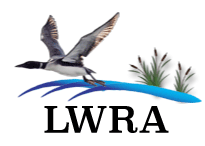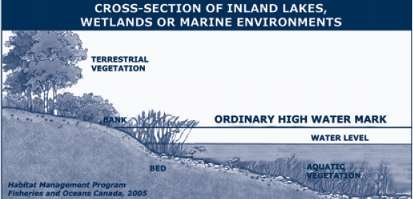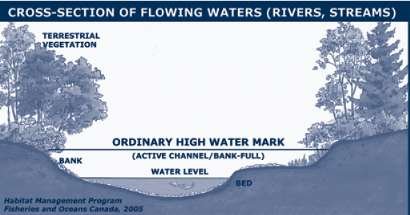Dock, Boathouse and other Shoreline Construction
Projects Near Water
If you are conducting a project near water, it is your responsibility to ensure you comply with all applicable regulations. The Ontario Ministry of Natural Resources, the Federal Department of Fisheries and Oceans and Transport Canada all have overlapping responsibilities and sometimes conflicting requirements. The following is a composite of some of the most common issues that our members may face.
PLEASE NOTE: This is not legal advice and is provided without any warranty whatsoever. You are advised to verify the requirements for your particular project or retain professional assitance.
If your project meets the criteria listed below, it will likely be acceptable to all regulatory agencies
NOTE: Most projects must respect the timing window for fish spawning. Our area and species means most in-water work is prohibited between March 15 and July 15.
Swim Platforms
The platform must be connected to an anchor with a chain, with a 360 degree swivel at the anchor.
The size can be no greater than 3 m x 3 m (10 ft. x 10 ft.) and the deck must be at least 50 cm (20 in.) above the water and all corners marked with retro-reflective markers.
The raft must be as close as possible to the shore but no more than 30 m (100 ft.) out from shore.
The raft must be removed from the water at the end of the swimming season.
The raft must be at least 4.5 m (15 ft.) from the side lot lines as projected into the water and located directly in front of the owners property.
The raft must not interfere with access from neighbouring properties or interfere with traditional recreational use patterns and activities on the waterbody.
Docks
All new construction, repair or rebuild of a floating, cantilever or post dock where total combined footprint does not exceed 15 m2
All removal activities except where rock filled cribs are to be removed and would be considered dredging
Boat Houses
New construction, repairs or rebuilds of boat houses where total combined footprint does not exceed 15 m2
No temporary or permanent increase in footprint below the High Water Mark
No new temporary or permanent fill placed below the High Water Mark
All removal activities except where rock filled cribs are to be removed and would be considered dredging
NOTE: Certain types of structures over the water; for example, two storey boathouses, single storey boathouses with living accommodations, docks not fronting your property and revenue producing docks, are not classified as "free uses of Crown land". As a result, although you may not need a work permit, you may require land use occupational authority under the Public Lands Act.
Boat Launches/Ramps
Construction or repairs
No temporary or permanent increase in existing footprint below the High Water Mark
No new temporary or permanent fill placed below the High Water Mark
All removal activities
Aquatic Vegetation Removal
Removal of aquatic vegetation by hand or mechanical cutting for existing swimming areas and private boat access
Areas less than 4 meters in width (measured along the shoreline) and of any length (out from the shore)
Removal of invasive aquatic vegetation from shore lands
Dredging
Dredging for private boat access
Area being dredged is less than 4 meters in width (including the side sloping), 10 meters in length (measured out from the shore), and 6 square meters in total area
Marina routine maintenance dredging
No temporary or permanent increase in existing footprint below the High Water Mark
Dredging material is deposited and stabilized on land (no open water disposal)
Dredging has occurred in the last 5 years
Moorings
All installations of new moorings and repairs to existing moorings
All removal activities
Excavation
In land excavation for nearshore development
All work is conducted above the High Water Mark
No alteration of water levels in nearby waterbodies
No excavation in seasonally inundated areas and floodplains
Shoreline/Bank Stabilization
Shoreline/bank stabilization such as rock protection, plantings and bioengineering
No temporary or permanent increase in existing footprint below the High Water Mark
No new temporary or permanent fill placed below the High Water Mark
Beaches
Installation and replenishment of private and public beaches
All sand is isolated and contained above the High Water Mark such that sand cannot wash into the water
Water Intakes
Installation of and repairs to water intakes
No temporary or permanent increase in existing footprint below the High Water Mark
No new temporary or permanent fill placed below the High Water Mark
Use fish screens to avoid killing fish
All removal activities
Habitat Restoration
Restoration projects undertaken with the sole purpose of improving or repairing existing habitats including riparian planting, shoreline/bank stabilization, bio-engineering and creation of in-stream structure
No new temporary or permanent fill placed below the High Water Mark
Any obstruction to fish passage will respect timing windows
Beaver Dam Removal
Gradual removal of beaver dams by hand or machinery
Flooding can be prevented
Any obstruction to fish passage will respect timing windows
Measures to Protect Fish and Fish Habitat when Building your Dock and Boathouse
1. Use existing trails, roads, or cut lines wherever possible to avoid disturbance to the riparian vegetation (i.e., vegetation that occurs adjacent to the watercourse).
2. While this Operational Statement does not cover the clearing of riparian vegetation, the removal of select plants may be necessary to access the construction site. This removal should be kept to a minimum.
3. The construction of boathouses above the HWM is strongly encouraged in order to minimize impacts to fish habitat.
4. Floating, cantilever and post docks, and marine railways on posts for boathouse access, can be installed at any time.
5. Time the installation of crib docks to prevent disruption of sensitive fish life stages by adhering to appropriate fisheries timing windows (see the Ontario In-Water Construction Timing Windows).
6. Construct cribs in an open-faced manner and fill with large rocks that provide crevices for fish and other small organisms. Leave enough space between cribs (two metres) and locate them at least two metres from the HWM to allow near shore water to circulate.
7. Do not take materials (e.g., rock, logs) to build the dock from the shoreline, from below the HWM or from any water body.
8. If rocks, stumps or logs need to be moved on the lake or river bottom or shoreline to build the dock, they should be relocated to an area of similar depth and not removed altogether from the bottom or shoreline.
9. Install effective sediment and erosion control measures before starting work to prevent the entry of sediment into the watercourse. Inspect them regularly during the course of construction and make all necessary repairs if any damage occurs.
9.1. Avoid doing work during wet and rainy periods.
10. Use untreated materials (e.g. cedar, tamarack, hemlock, rocks, plastic, etc.) as supports for dock structures that will be submerged in water. Treated lumber may contain compounds that can be released into the water and become toxic to the aquatic environment.
10.1. Use only treated lumber that is environmentally-friendly (see definition below) for dock structures that are above water.
10.2. Cut, seal and stain all lumber away from the water using only environmentally-friendly stains (see definition below). All sealed and stained lumber should be completely dry before being used near water.
10.3. Ensure plastic barrel floats are free of chemicals inside and outside of the barrel before they are placed in water.
11. Wherever possible, construct the dock either from a barge or float on the water or through the ice instead of using machinery from the bank of the water body.
12. Operate machinery on land (from outside of the water) and in a manner that minimizes disturbance to the banks of the water body.
12.1. Machinery is to arrive on site in a clean condition and is to be maintained free of fluid leaks.
12.2. Wash, refuel and service machinery and store fuel and other materials for the machinery away from the water to prevent any deleterious substance from entering the water.
12.3. Keep an emergency spill kit on site in case of fluid leaks or spills from machinery.
12.4. Restore banks to original condition if any disturbance occurs.
13. If a concrete abutment is needed to secure your dock to land install it entirely on land, above the HWM. The concrete is to be pre-cast and cured away from the water before use to prevent seepage of potentially toxic substances into the water body.
14. Prevent deleterious substances such as uncured concrete, grout, paint, sediment and preservatives from entering the water body or storm drains.
15. Vegetate any disturbed areas by planting and seeding preferably with native trees, shrubs or grasses and cover such areas with mulch to prevent erosion and to help seeds germinate. If there is insufficient time remaining in the growing season, the site should be stabilized (e.g., cover exposed areas with erosion control blankets to keep the soil in place and prevent erosion) and vegetated the following spring.
15.1. Maintain effective sediment and erosion control measures until re-vegetation of disturbed areas is achieved.
If you would like more detailed information on fish-friendly dock construction and maintenance practices to help you plan your project, please refer to the following document: The Dock Primer -A Cottager's Guide to Waterfront-Friendly Docks
Definitions:
Ordinary high water mark (HWM) - The usual or average level to which a body of water rises at its highest point and remains for sufficient time so as to change the characteristics of the land. In flowing waters (rivers, streams) this refers to the "active channel/bank-full level" which is often the 1:2 year flood flow return level. In inland lakes, wetlands or marine environments it refers to those parts of the water body bed and banks that are frequently flooded by water so as to leave a mark on the land and where the natural vegetation changes from predominately aquatic vegetation to terrestrial vegetation (excepting water tolerant species). For reservoirs this refers to normal high operating levels (Full Supply Level).
For the Great Lakes this refers to the 80th percentile elevation above chart datum as described in DFO's Fish Habitat and Determining the High Water Mark on Lakes.
Environmentally-friendly lumber and stains - Chemical wood preservatives used in Canada are regulated by the Pest Management Regulatory Agency, Health Canada. Approved preservatives used most commonly in lumber are Alkaline Copper Quaternary (ACQ) and Copper Azole (CA). Creosote treated wood should not be used in or near water. Ask your local building supply outlet for further information on available products.


